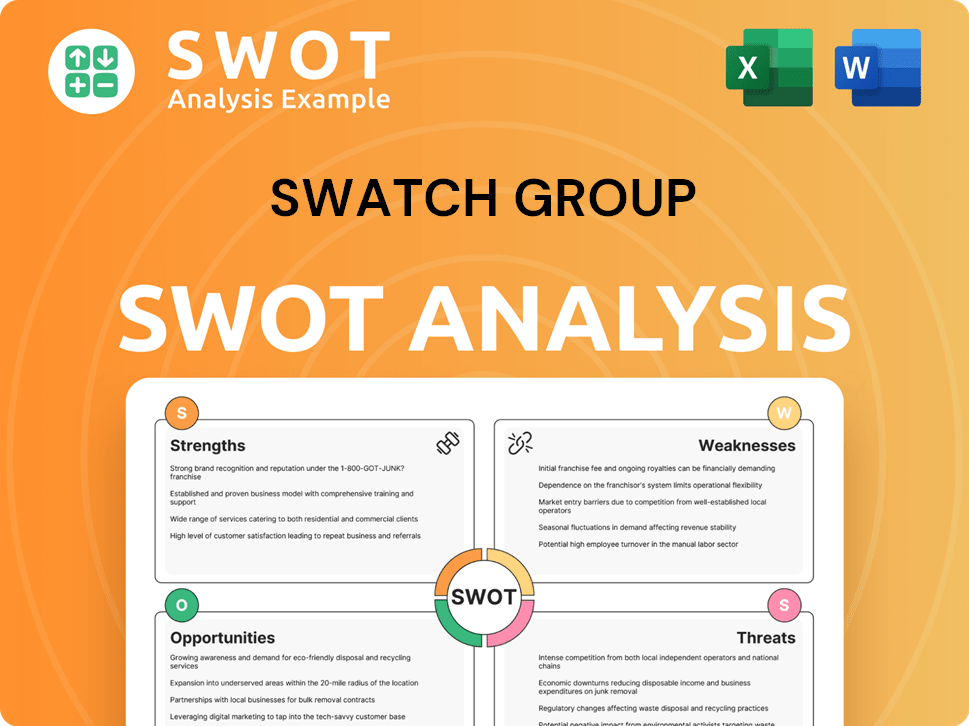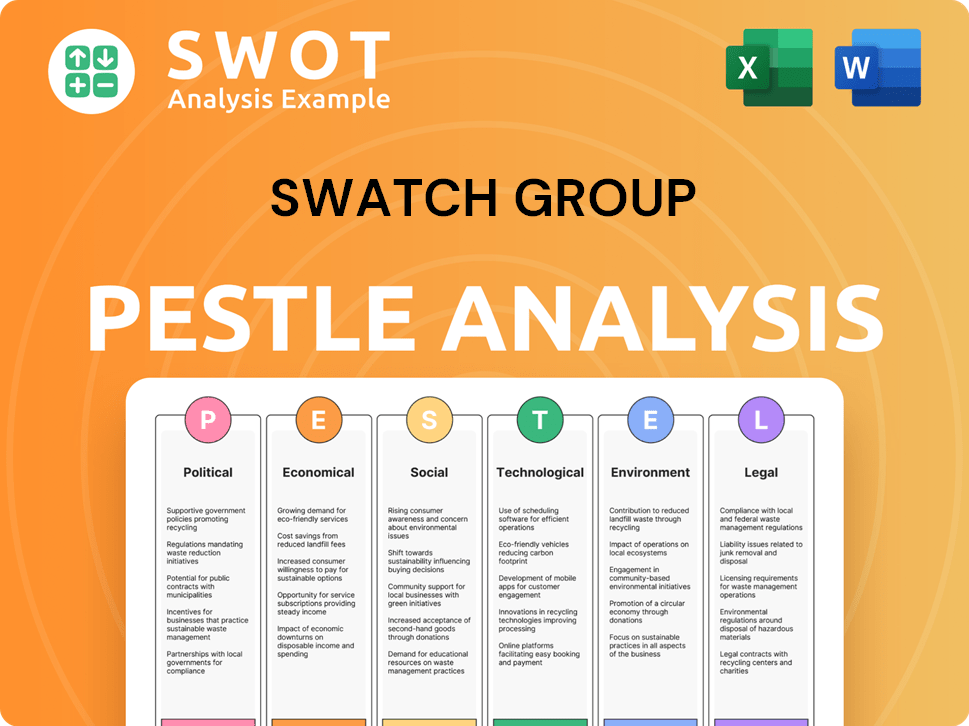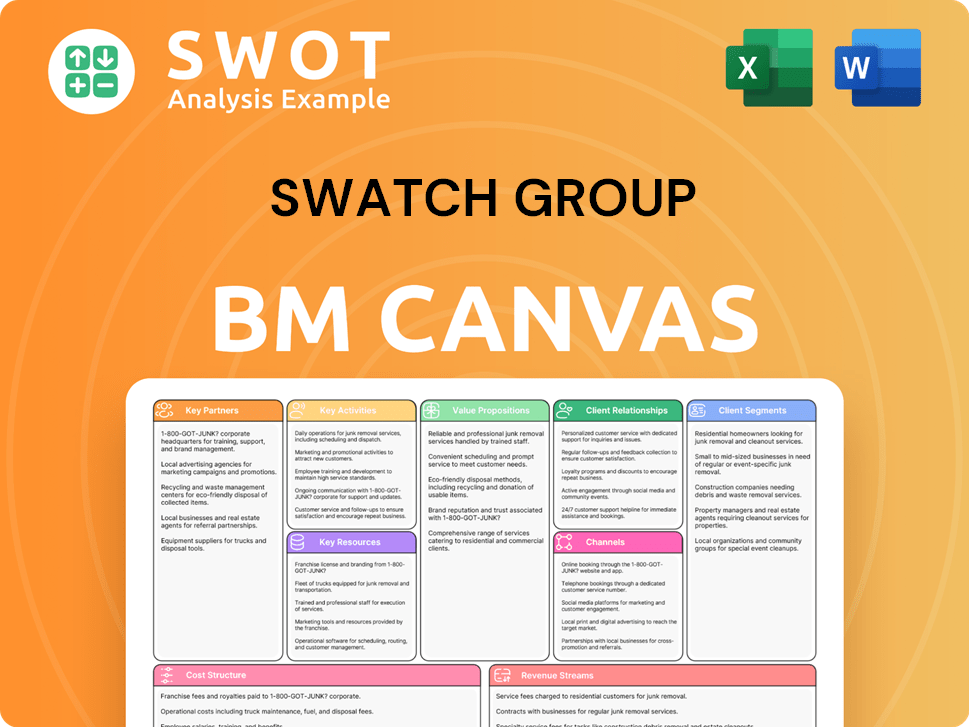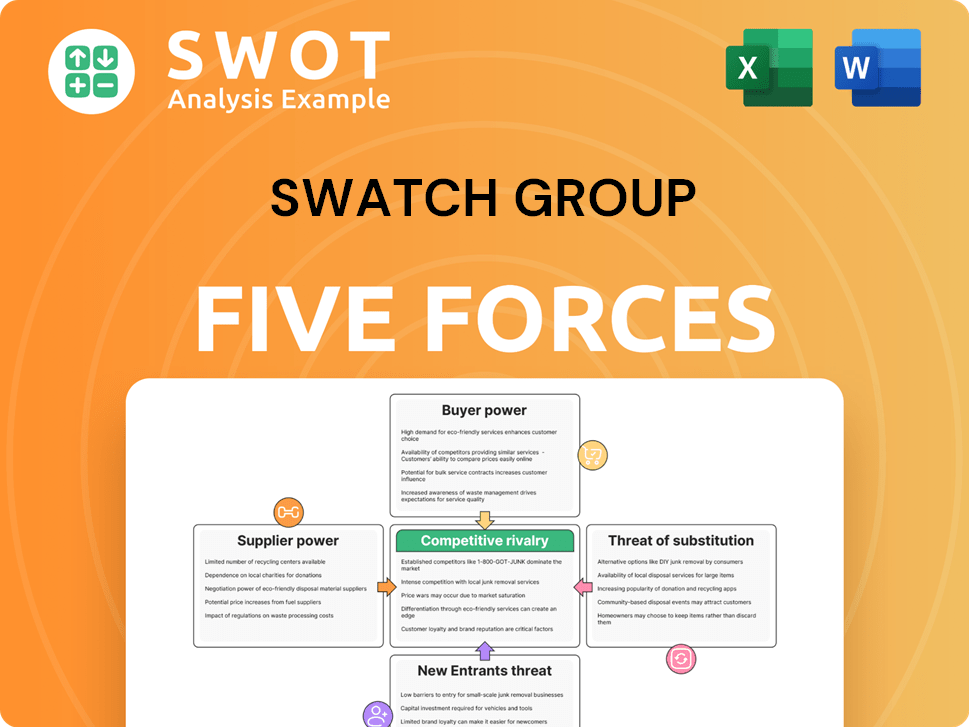Swatch Group Bundle
Can Swatch Group Maintain Its Dominance in the Watchmaking World?
The Swatch Group, a powerhouse in the Swiss watch industry, has navigated decades of market shifts, from the quartz crisis to the rise of smartwatches. Its success story, built on iconic brands and strategic acquisitions, is a masterclass in adaptation. But in today's dynamic Swatch Group SWOT Analysis, how does this horological giant stack up against its rivals?

Understanding the Swatch Group competitive landscape is crucial for anyone seeking to understand the Swiss watch industry. This analysis will dissect the Swatch Group competitors, examining their strengths, weaknesses, and strategies. We'll delve into the Swatch Group market analysis, exploring its market share, brand portfolio, and how it maintains its position in the luxury watch market amidst constant change and innovation, including Swatch Group's main rivals and their impact on Swatch Group's financial performance compared to competitors.
Where Does Swatch Group’ Stand in the Current Market?
The Swatch Group holds a prominent position in the global watchmaking industry, distinguished by its diverse brand portfolio and comprehensive market coverage. Its strategic approach spans from entry-level to ultra-luxury segments, ensuring a broad customer base. The group's financial strength, as demonstrated by its reported net sales of CHF 7,888 million in 2023, underscores its significant market presence.
The company's market position is reinforced by a robust global presence, with sales in over 150 countries. Key markets include Asia (particularly China), Europe, and North America, where demand for luxury and mid-range watches remains strong. The group's ability to adapt to market changes, such as introducing the Swatch brand to counter the quartz crisis, highlights its strategic agility. Moreover, the group's vertical integration, controlling the manufacturing of nearly all components, further solidifies its market standing by ensuring quality control and supply chain resilience.
The Swatch Group's competitive landscape is shaped by its extensive brand portfolio, which includes 18 watch brands. This allows the group to cater to a vast customer base across different demographics and purchasing power. The group faces intense competition in the smart wearables market, an area where traditional watchmakers are still finding their footing against tech giants. For further insights into the group's strategic initiatives, consider exploring the Growth Strategy of Swatch Group.
The Swatch Group consistently ranks among the top global watch manufacturers by sales volume and value. While precise market share figures for 2024-2025 are subject to market dynamics, its financial performance in 2023, with net sales of CHF 7,888 million, indicates a strong position.
The group's diverse brand portfolio, encompassing 18 watch brands, is a key strength. This allows the Swatch Group to target a wide range of consumers, from those seeking affordable options to those desiring high-end luxury timepieces.
The Swatch Group has a robust global presence, with sales in over 150 countries. Key markets include Asia (particularly China), Europe, and North America, where demand for luxury and mid-range watches remains strong.
The group's vertical integration, controlling the manufacturing of nearly all components, ensures quality control and supply chain resilience. This strategic advantage helps maintain its market position and competitive edge within the Swiss watch industry.
The Swatch Group faces competition from both traditional watchmakers and technology companies in the smart wearables market. The group's ability to innovate and adapt to changing consumer preferences is crucial. Its strategic focus on digital presence and e-commerce capabilities is essential to meet evolving purchasing habits.
- Strong brand portfolio across various price points.
- Global distribution network with a presence in over 150 countries.
- Vertical integration to ensure quality control and supply chain efficiency.
- Focus on digital presence and e-commerce to meet evolving consumer demands.
Swatch Group SWOT Analysis
- Complete SWOT Breakdown
- Fully Customizable
- Editable in Excel & Word
- Professional Formatting
- Investor-Ready Format

Who Are the Main Competitors Challenging Swatch Group?
The Revenue Streams & Business Model of Swatch Group faces a complex competitive environment, shaped by various players across different market segments. Understanding the competitive landscape is crucial for assessing the company's position and future prospects. This analysis considers both traditional watchmakers and emerging tech companies that challenge the Swiss watch industry.
The competitive dynamics within the Swatch Group competitive landscape are influenced by factors such as brand positioning, distribution networks, technological innovation, and marketing strategies. The luxury watch market, the mid-range segment, and the smartwatch sector each present unique challenges and opportunities. Analyzing these competitive pressures provides insights into the strategic decisions Swatch Group must make to maintain and grow its market share.
The Swatch Group's market analysis reveals a multi-faceted competitive environment. The company's success depends on its ability to navigate this landscape effectively. This includes adapting to changing consumer preferences, technological advancements, and the evolving strategies of its rivals.
Richemont and LVMH are major competitors in the luxury watch market. These companies compete directly with brands like Omega, Breguet, and Blancpain. They often engage in intense competition in key regions, such as China and the Middle East.
Rolex (including Tudor) and Patek Philippe are significant competitors. Rolex's strong brand recognition and robust resale market influence consumer expectations. Japanese watchmakers such as Seiko and Citizen also compete in this segment.
Apple, Samsung, and Huawei pose a challenge, especially to Swatch and Tissot. These tech companies offer advanced functionalities, appealing to a younger, tech-savvy demographic. The Swatch Group faces challenges due to rapid innovation cycles.
Direct-to-consumer brands and online retailers disrupt traditional distribution channels. They offer personalized customer experiences. This shift impacts the Swatch Group's distribution strategies.
Luxury brands focus on heritage, craftsmanship, and exclusive distribution. Mid-range brands emphasize quality and design. Smartwatch makers prioritize technological advancements and ecosystem advantages.
The luxury watch market is highly competitive, with brands vying for market share in key regions. The mid-range segment sees strong competition from both Swiss and Japanese watchmakers. The smartwatch market is dominated by tech giants.
The Swatch Group's competitive advantages are influenced by several factors. These include brand portfolio, distribution networks, and innovation. The challenges in the watch market require strategic adaptation.
- Brand Portfolio: The diverse range of brands caters to various market segments, from luxury to accessible luxury and fashion.
- Distribution Channels: A well-established global network of retail stores, online platforms, and partnerships.
- Innovation: Continuous development in watchmaking technology, including materials, movements, and smart features.
- Marketing and Branding: Effective campaigns that enhance brand recognition and appeal to target consumers.
- Pricing Strategy: A pricing strategy that balances premium positioning with competitiveness.
Swatch Group PESTLE Analysis
- Covers All 6 PESTLE Categories
- No Research Needed – Save Hours of Work
- Built by Experts, Trusted by Consultants
- Instant Download, Ready to Use
- 100% Editable, Fully Customizable

What Gives Swatch Group a Competitive Edge Over Its Rivals?
The competitive advantages of the Swatch Group are primarily rooted in its diverse brand portfolio, its integrated manufacturing processes, and its extensive global distribution network. This combination allows the group to effectively compete across various segments of the watch market, from accessible entry-level timepieces to high-end luxury watches. Understanding the Swatch Group competitive landscape is crucial for assessing its market position and future prospects.
The group's vertical integration, particularly through its movement manufacturer ETA SA Manufacture Horlogère Suisse, provides a significant edge. This control over the supply chain ensures quality, reduces dependency on external suppliers, and allows for cost efficiencies. This strategic approach significantly impacts the Swatch Group market analysis and its ability to navigate the complexities of the Swiss watch industry.
The group's strong brand equity and heritage, especially for iconic brands like Omega and Longines, foster customer loyalty and support premium pricing strategies. The company's ongoing investments in e-commerce and digital marketing are aimed at enhancing its online presence and adapting to evolving consumer behaviors. To learn more about the foundation of the company, you can check out the Brief History of Swatch Group.
The Swatch Group's wide range of brands allows it to cater to diverse consumer segments. This diversification mitigates risks associated with market fluctuations in any single segment. The portfolio includes brands like Omega, Longines, Tissot, and Swatch, among others.
The group's control over its supply chain, including movement manufacturing, offers significant advantages. This integration ensures quality control and reduces reliance on external suppliers. ETA SA Manufacture Horlogère Suisse is a key component of this strategy.
A robust distribution network, including boutiques, multi-brand retailers, and e-commerce, ensures widespread product availability. This extensive reach strengthens brand visibility worldwide. The group's distribution strategy is a key factor in its market success.
Iconic brands like Omega and Longines benefit from strong brand equity and heritage, fostering customer loyalty. These brands command premium pricing and benefit from associations with events like the Olympics. This is a key aspect of the luxury watch market.
The Swatch Group's competitive advantages are multifaceted, encompassing brand diversity, vertical integration, and a global distribution network. These elements support the group's ability to compete effectively against its Swatch Group competitors in the global watch market. The group's financial performance, compared to its competitors, is also a key indicator of its success.
- Brand Portfolio: A diverse range of brands addressing different market segments.
- Vertical Integration: Control over manufacturing processes, including movement production.
- Distribution Network: Extensive global reach through various channels.
- Brand Equity: Strong heritage and customer loyalty for iconic brands.
Swatch Group Business Model Canvas
- Complete 9-Block Business Model Canvas
- Effortlessly Communicate Your Business Strategy
- Investor-Ready BMC Format
- 100% Editable and Customizable
- Clear and Structured Layout

What Industry Trends Are Reshaping Swatch Group’s Competitive Landscape?
The watchmaking industry is currently experiencing significant shifts, presenting both challenges and opportunities for companies like the Swatch Group. These changes are driven by evolving consumer preferences, technological advancements, and global economic conditions. Understanding the Swatch Group competitive landscape is crucial for assessing its position and future prospects within the Swiss watch industry.
Key risks include the rise of smartwatches and economic downturns, while opportunities lie in emerging markets and technological innovation. The Swatch Group's market analysis must consider these factors to maintain its competitive edge. The company's ability to adapt to these trends will determine its long-term success and Swatch Group's future growth prospects.
The increasing popularity of smartwatches and wearable technology is a significant trend, particularly among younger consumers. The luxury watch market is seeing a shift towards personalized experiences and direct-to-consumer sales. Sustainability and ethical sourcing are becoming increasingly important to consumers, influencing purchasing decisions.
Potential economic downturns could impact discretionary spending on luxury goods. Geopolitical instability may affect supply chains and market access. Intense competition from traditional watchmakers and tech giants poses a constant challenge. The grey market and counterfeiting remain persistent threats to brand integrity and sales.
Emerging markets, especially in Southeast Asia and Africa, offer new consumer bases. Leveraging big data and AI for personalized marketing and predictive analytics can enhance customer engagement. Continued investment in research and development can drive innovation. Strategic brand management and flexible distribution are key.
The Swatch Group needs to innovate its connected watch offerings, balancing functionality with aesthetic appeal. Enhance sustainability efforts to meet consumer demand. Strengthen direct relationships with customers through boutiques and e-commerce. Adapt to evolving consumer preferences and technological advancements.
The Swatch Group must navigate the evolving landscape by focusing on innovation, sustainability, and customer engagement. Key factors include adapting to the rise of smartwatches, addressing supply chain challenges, and expanding into emerging markets. For a deeper understanding of the consumer base, consider exploring the Target Market of Swatch Group.
- Innovation: Develop advanced connected watches and explore new technologies.
- Sustainability: Enhance sustainable manufacturing and sourcing practices.
- Market Expansion: Target growth in Southeast Asia and African markets.
- Customer Engagement: Utilize data analytics for personalized marketing.
Swatch Group Porter's Five Forces Analysis
- Covers All 5 Competitive Forces in Detail
- Structured for Consultants, Students, and Founders
- 100% Editable in Microsoft Word & Excel
- Instant Digital Download – Use Immediately
- Compatible with Mac & PC – Fully Unlocked

Related Blogs
- What are Mission Vision & Core Values of Swatch Group Company?
- What is Growth Strategy and Future Prospects of Swatch Group Company?
- How Does Swatch Group Company Work?
- What is Sales and Marketing Strategy of Swatch Group Company?
- What is Brief History of Swatch Group Company?
- Who Owns Swatch Group Company?
- What is Customer Demographics and Target Market of Swatch Group Company?
Disclaimer
All information, articles, and product details provided on this website are for general informational and educational purposes only. We do not claim any ownership over, nor do we intend to infringe upon, any trademarks, copyrights, logos, brand names, or other intellectual property mentioned or depicted on this site. Such intellectual property remains the property of its respective owners, and any references here are made solely for identification or informational purposes, without implying any affiliation, endorsement, or partnership.
We make no representations or warranties, express or implied, regarding the accuracy, completeness, or suitability of any content or products presented. Nothing on this website should be construed as legal, tax, investment, financial, medical, or other professional advice. In addition, no part of this site—including articles or product references—constitutes a solicitation, recommendation, endorsement, advertisement, or offer to buy or sell any securities, franchises, or other financial instruments, particularly in jurisdictions where such activity would be unlawful.
All content is of a general nature and may not address the specific circumstances of any individual or entity. It is not a substitute for professional advice or services. Any actions you take based on the information provided here are strictly at your own risk. You accept full responsibility for any decisions or outcomes arising from your use of this website and agree to release us from any liability in connection with your use of, or reliance upon, the content or products found herein.